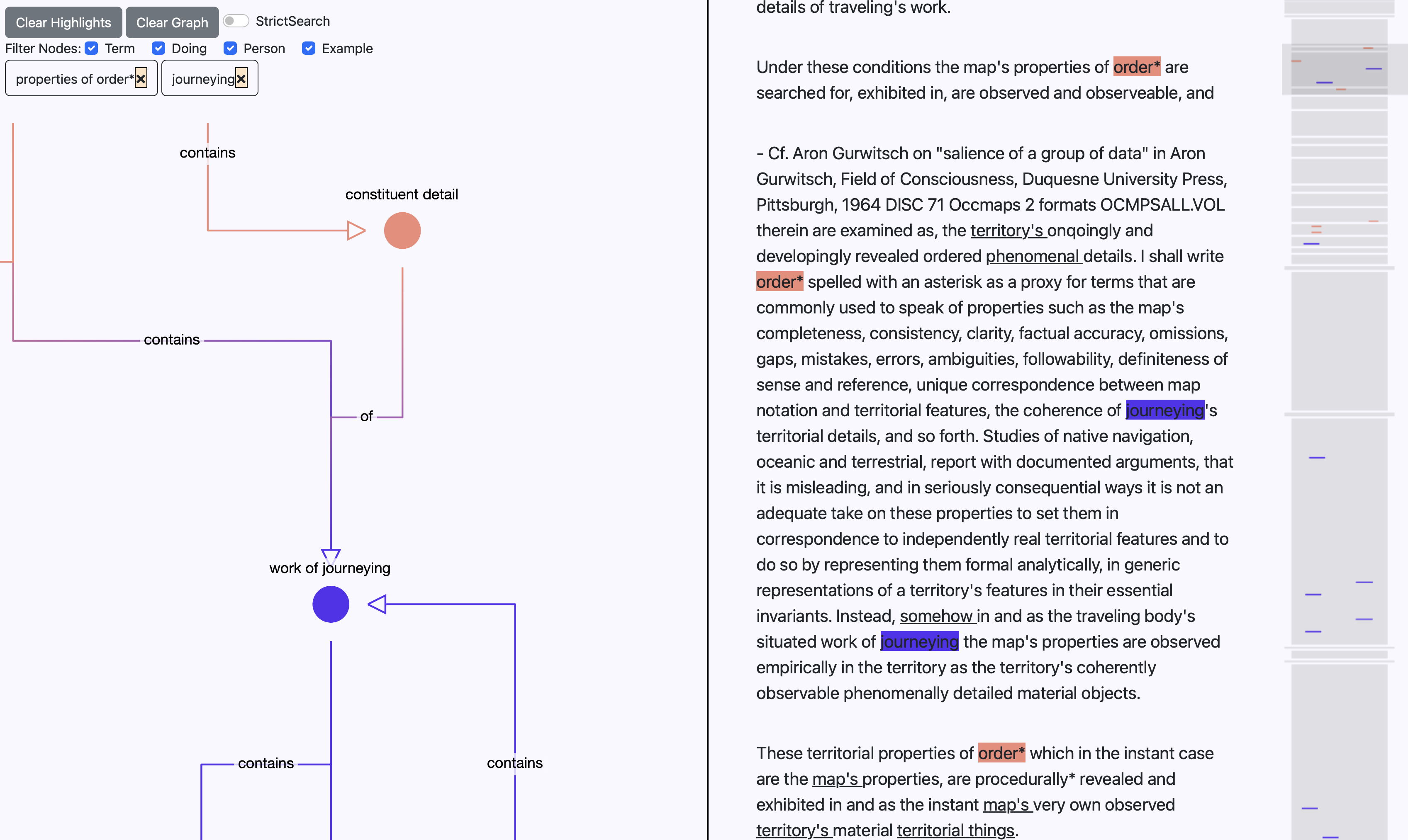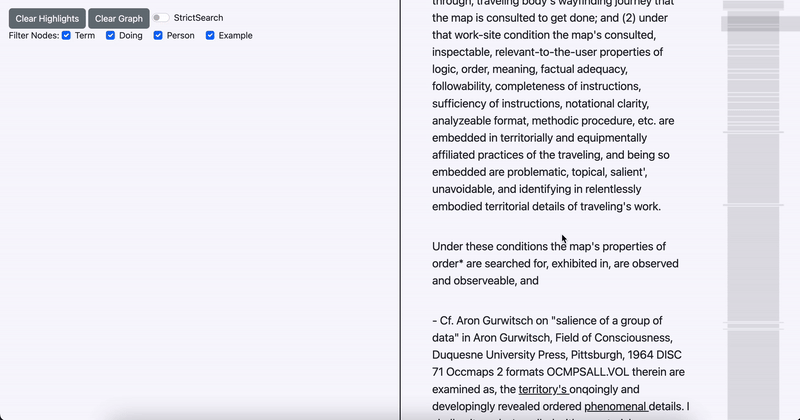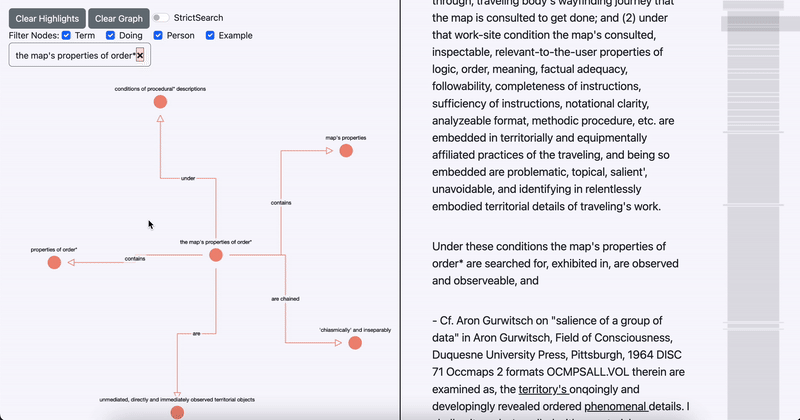Graphing "Occasion Maps" Phrases
Go directly to Graph/Text Viewer
a web application aimed at exploring the linguistic maze of Harold Garfinkel, offers a dual perspective to his work: as a text and as a graph.

Ethnomethodology utilizes a language characterized by a specific phrasing structure and an abundance of descriptors to elucidate everyday practices, facilitating the observation of their dynamics. Garfinkel's work, in particular, unfolds through three reading dimensions: vertically, following the argumentation chain; horizontally, as descriptors are unpacked and described; and circularly, as descriptors acquire new properties in the text's progression.
This multidimensional nature can make reading ethnomethodological studies challenging for novices. The circular and horizontal unfoldings of descriptors may be overlooked in traditional vertical reading. The graphing approach combined with a synchronized text view not only facilitates exploration of every descriptor and its relationships but also allows marking descriptors on the text, enabling vertical reading from different positions. This way, specific descriptors used in various sections of the same text can be unfolded.

Usage
The application displays both views side by side and begins with an empty graph view. When a word or phrase is highlighted with the cursor, the graph view loads the corresponding node in the center of the graph along with its immediate relationships. If additional words are highlighted, the corresponding nodes are added to the graph view.
Nodes can be filtered using the menu on the upper left side of the app. Firstly, you can query nodes through a strict search, where the highlighted words are searched in the database as they are. Alternatively, you can use a partial match search, which queries the database for nodes containing the highlighted text. Secondly, nodes can be filtered by their main types: terms, doings, persons and examples. Under the menu, highlighted words or phrases are displayed, and they can be excluded by clicking on the 'x' button.

When a node is selected two buttons appear. With the explore button nodes with immediate relationships to the selected node get displayed, expanding the graph view. To explore the relationships graph view can be zoomed in or out. Mark button highlights the word or phrase on the node in the text view. The occurances can be also seen on the minimap class="px-2"view on the most right side, so that an overview can be gained. Multiple nodes can be marked at the same time and their occurances get highlighted with different colors according to their types.

fundamental question and some background
The process of digitizing Occasion Maps Papers accompanied by the fundamental question of granularity: what should be the smallest unit of this collection to be recorded and constituted as an object? As a “native” digitization approach got executed, every scan was described as an item. At the same time being “part of” an another item unit or “state” of the same item was noted and a title and type was assigned.
At this level of detail, a problem remains unresolved that is not unfamiliar to ethnomethodology. In order to achieve a meaningful retrieval of the items that have been constituted, a system must be in place to arrive at locally relevant units. A typical library or collection catalog, which consists of titles, types, or dates, only provides access to the things that the user assumes are there. This alleged objective information, although factual, does not grant access to the ideas contained in the units or their contextual unfoldings. Limiting the recording of a collection to structural common denominators of constituted items, which in return constitutes the collection, takes away their local and ethnomethodological relevance.
As Harold Garfinkel describes Occasion Maps as an ethnomethodological model (e.g. Ethnomethodology's Program: Working Out Durkheim's Aphorism 2002, p. 128, 129 and Harold Garfinkel: Studies of Work in the Sciences 2022, chapter Seminar 2 (May 27, 1980), p. 131) as an alternate to materials of analytic cartography, he mentions Zatocoding technology in the same context as an alternate to generically theorized structures. The relationship class="px-2"is that the Occasion Maps and Zatocoding reveal definitive properties of occasioned expression, through the lived work of wayfinding journey and context-focused practices of cataloging without rigid and systematic expectations, respectively. Calvin N. Mooers, the developer of Zatocoding, defines his approach as a system “which superimposes random subject code patterns on the tally” (Zatocoding applied to mechanical organization of knowledge 1949, p. 21). Basically it’s an early tagging system and allows a flexible parallel retrieval to a predefined and rigid one. To discover the particularities of Zatocoding as ethnomethodological model Garfinkel’s Student H.L. Wood conducted a study, in which he coded 500 items with 44 descriptors (tags). He details his encounter with “troubles” in great detail in his paper from 1969. In essence he experiences a form of “vertigo” by having to assign significance through descriptors, which shifts meaning as they get assigned.
lowest level of granularity
These relationship class="px-2"facilitated a drastic idea of coding and a hybrid study involving Occasion Map class="px-2"Papers, encompassing the definition of granularity at a word level and an examination of the lived-work associated with such an approach. The motivation behind this lies not only in the radical nature of deconstructing an item into its atomary parts but also in recognizing the significance of words as forms of speech within ethnomethodology.
As Garfinkel tried to describe the mundane practices of everyday life as a constituent of social orderliness, he realized that language as it is used and taken for granted can not unveil the woven inner workings of what is being researched. As Anne Rawls puts it:
“Garfinkel is arguing that objects don't just exist. They need to be accomplished.
And the process of their accomplishment is what we're looking at. We have a language that treats parts of speech as standing in a referential relationship with epistemic objects,
and you need to use that language in order to talk about the theory that says that no they in fact don't have that ontological characteristics. So, Garfinkel uses a lot of phrases:
as of which (the car) as a feature of the situation as of which it is a part.”
[The Australian Institute for Ethnomethodology and Conversation Analysis. “Anne Rawls on Harold Garfinkel and ethnomethodology”. Online Video. YouTube. 14.09.2011. Web.]
This means that (1) the particular language utilized by ethnomethodology reflects the particularities of the field of study, and (2) the use of complex phrases and an abundance of descriptors is not accidental or a stylistic choice. It is well-thought-out and intertextually relevant.
Implementation
Although the collection consists of thousands of notes, transcripts of recordings, student works etc., a meta analysis showed that the ideas of Garfinkel developed over time through modification and extensions of his phrases and reached a supposed maturity in the 1990’s in the form of grant applications. In this phase we see that the descriptors and formulations about occasion maps stabilize.
[vergleich grafik von Andreas?]
To implement the
graph approach, a grant application with the title “Notes Comparing Two Analytic Formats of Occasion
Maps of Way Finding Journeys: ‘Documentary’ and ‘Essentially Procedural” from 1996 was chosen as the
supposed peak form of his formulations regarding Occasion Maps.
Over the course of 60 hours of data sessions partly with Prof. Dr. Tristan Thielmann and his students, the text got broken down into its atomary parts. Complex nested descriptors and circular revisitations of phrases were recorded as semantic relationships in a Neo4J database.

While the effort started with the notion of assumed naivety, meaning a coding practice as close to text as possible, some crucial interpretative decisions have to be made. Four types are assigned to nodes accordingly: terms, doings, persons, and examples. The purpose of it mainly was to distinguish between terms as descriptors and doings, which correspond directly with practices that persons do. While the relationships are recorded mostly as they are stated in the text, some relationships are added to depict phrases consisting of multiple words, i.e., nodes. For example, the nodes 'properties' and 'order*' are recorded with the relationship 'of,' as it is stated in the text, while they are connected to the node 'properties of order*' with the interventive relationship class="px-2"'contains'. Such interventions in the relationships are marked with an underscore ('_') to differentiate from the relationships taken from the text.
Although the resulting graph in Neo4J allows access to text from arbitrary descriptors and opens up class="px-2"the relations beyond the linearity of text structure, a need to project the dimensions back into the text emerged. Semantic markup class="px-2"in standards like TEI is inherently bound to linear readings of a text and only offers intertextual references and connections if those are specifically and explicitly encoded based on one interpretation. By reading the text “naively” as a graph, intertextual connections can emerge organically (by node-merging). Projecting the graph back onto the text allows the reader to read through text linearly but at the same time, open up the descriptor into its relations as a graph, so that a wider understanding of presented terms can be gained.
The resulting application shows the graph view side by side with a TEI encoded text view.

Users can select words or phrases in the text to see relations in graph view and vice versa. If a word in the graph is chosen, occurrences of the word become highlighted in the text view and a “minimap” displaying the entire document. The project proposes that this kind of reading not only enhances the sense-making regarding the specific text, but opens up class="px-2"an intertextual understanding of Garfinkel’s construction of phrases, so that insights into ethnomethodology can be gained.
Graphing approach and the application are presented with great success and visibility at the international Digital Humanities Conference 2023 in Graz hosted by Alliance of Digital Humanities Organizations. Especially the usage of this approach for bigger corpora of related research texts is discussed. This would allow to make intertextual relations visible and help class="px-2"to create a dynamic form of a glossary which would be non restrictive and expansive.